Resource Allocation and Market Efficiency: An Economic Analysis
VerifiedAdded on 2023/06/10
|9
|2615
|497
Report
AI Summary
This report provides a detailed analysis of resource allocation within an economic context, beginning with an explanation of the fundamental economic problem and how markets attempt to allocate scarce resources through capitalist, command, and mixed economies. It delves into the concept of market failure, attributing it to the inefficient use of resources and citing examples such as externalities, public goods, and imperfect information. The report further examines how consumer tastes and fashion trends influence demand and prices, and how governments intervene to correct negative externalities through taxation and subsidies. Finally, it discusses the government's role in influencing the allocation of merit and demerit goods, promoting the former through subsidies and discouraging the latter through taxes, with the revenues generated being used to fund public goods and services for societal benefit. This assignment is available on Desklib, a platform offering a wide array of study tools and solved assignments for students.
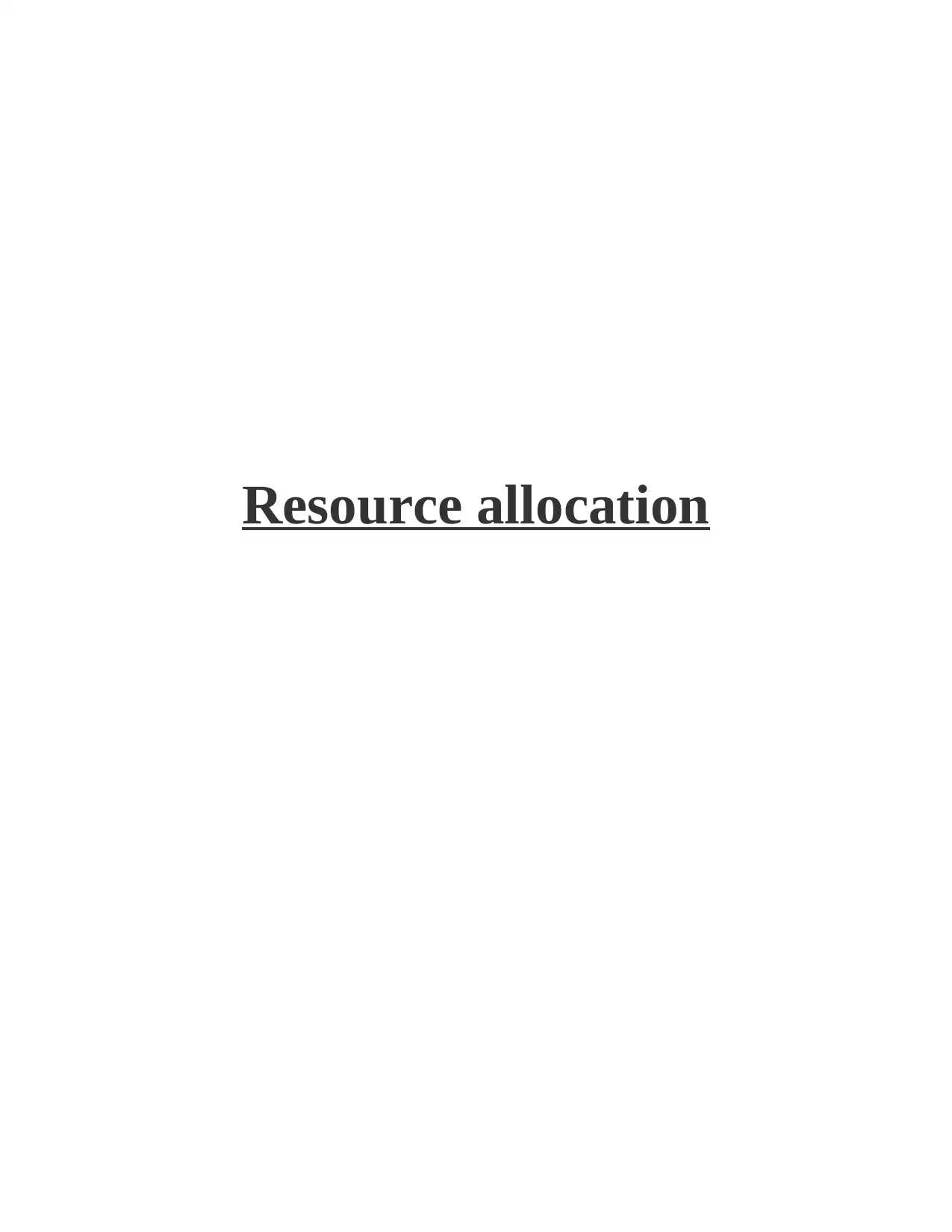
Resource allocation
Paraphrase This Document
Need a fresh take? Get an instant paraphrase of this document with our AI Paraphraser
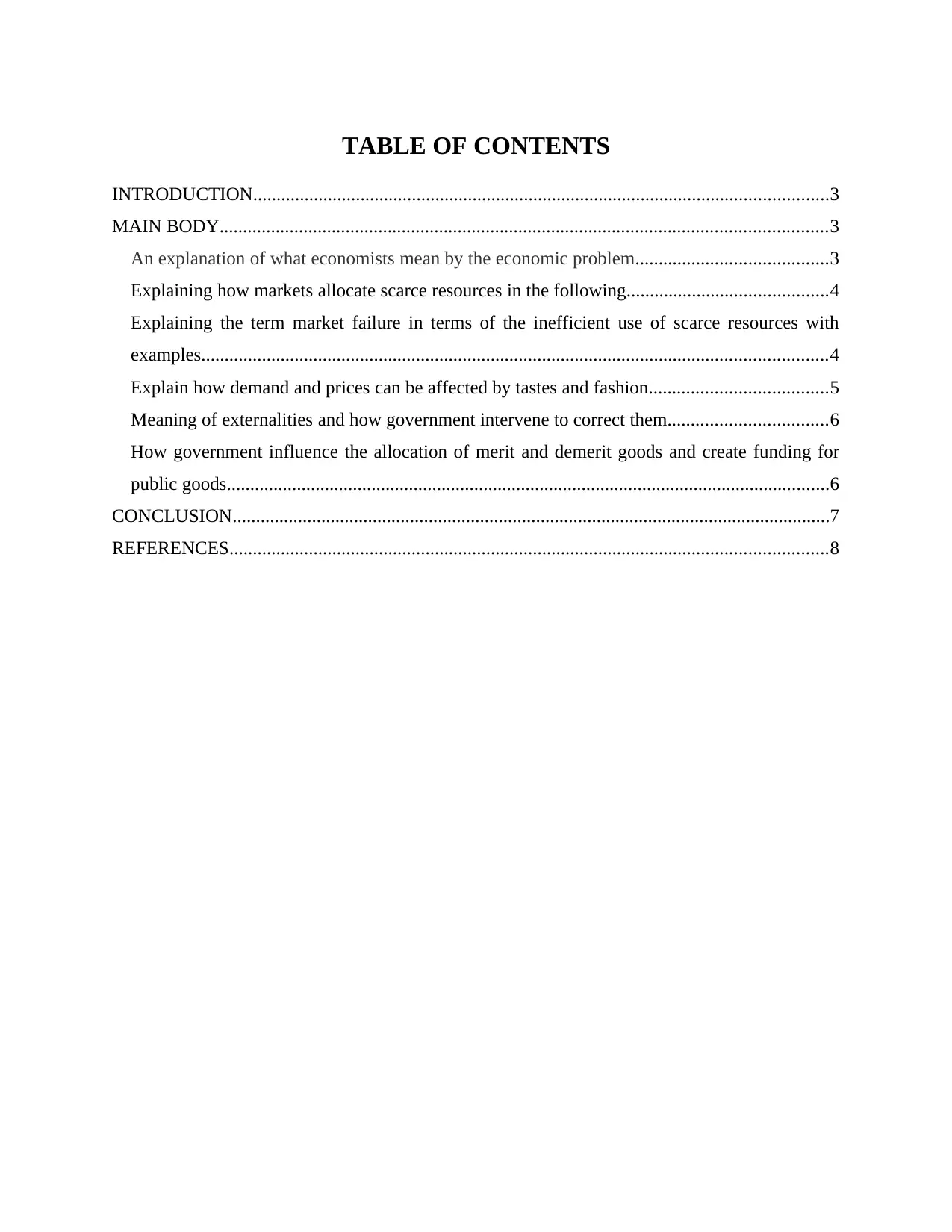
TABLE OF CONTENTS
INTRODUCTION...........................................................................................................................3
MAIN BODY..................................................................................................................................3
An explanation of what economists mean by the economic problem.........................................3
Explaining how markets allocate scarce resources in the following...........................................4
Explaining the term market failure in terms of the inefficient use of scarce resources with
examples......................................................................................................................................4
Explain how demand and prices can be affected by tastes and fashion......................................5
Meaning of externalities and how government intervene to correct them..................................6
How government influence the allocation of merit and demerit goods and create funding for
public goods.................................................................................................................................6
CONCLUSION................................................................................................................................7
REFERENCES................................................................................................................................8
INTRODUCTION...........................................................................................................................3
MAIN BODY..................................................................................................................................3
An explanation of what economists mean by the economic problem.........................................3
Explaining how markets allocate scarce resources in the following...........................................4
Explaining the term market failure in terms of the inefficient use of scarce resources with
examples......................................................................................................................................4
Explain how demand and prices can be affected by tastes and fashion......................................5
Meaning of externalities and how government intervene to correct them..................................6
How government influence the allocation of merit and demerit goods and create funding for
public goods.................................................................................................................................6
CONCLUSION................................................................................................................................7
REFERENCES................................................................................................................................8
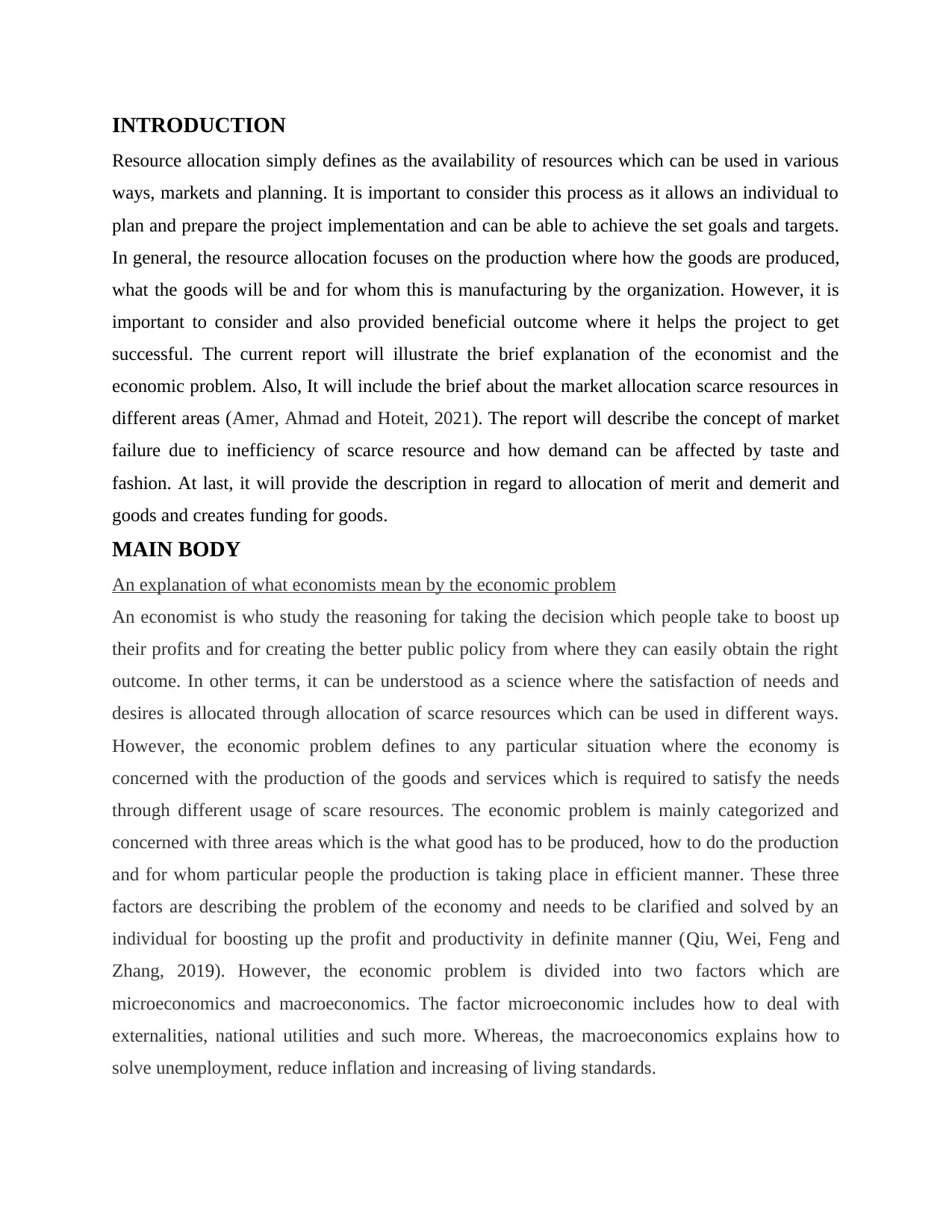
INTRODUCTION
Resource allocation simply defines as the availability of resources which can be used in various
ways, markets and planning. It is important to consider this process as it allows an individual to
plan and prepare the project implementation and can be able to achieve the set goals and targets.
In general, the resource allocation focuses on the production where how the goods are produced,
what the goods will be and for whom this is manufacturing by the organization. However, it is
important to consider and also provided beneficial outcome where it helps the project to get
successful. The current report will illustrate the brief explanation of the economist and the
economic problem. Also, It will include the brief about the market allocation scarce resources in
different areas (Amer, Ahmad and Hoteit, 2021). The report will describe the concept of market
failure due to inefficiency of scarce resource and how demand can be affected by taste and
fashion. At last, it will provide the description in regard to allocation of merit and demerit and
goods and creates funding for goods.
MAIN BODY
An explanation of what economists mean by the economic problem
An economist is who study the reasoning for taking the decision which people take to boost up
their profits and for creating the better public policy from where they can easily obtain the right
outcome. In other terms, it can be understood as a science where the satisfaction of needs and
desires is allocated through allocation of scarce resources which can be used in different ways.
However, the economic problem defines to any particular situation where the economy is
concerned with the production of the goods and services which is required to satisfy the needs
through different usage of scare resources. The economic problem is mainly categorized and
concerned with three areas which is the what good has to be produced, how to do the production
and for whom particular people the production is taking place in efficient manner. These three
factors are describing the problem of the economy and needs to be clarified and solved by an
individual for boosting up the profit and productivity in definite manner (Qiu, Wei, Feng and
Zhang, 2019). However, the economic problem is divided into two factors which are
microeconomics and macroeconomics. The factor microeconomic includes how to deal with
externalities, national utilities and such more. Whereas, the macroeconomics explains how to
solve unemployment, reduce inflation and increasing of living standards.
Resource allocation simply defines as the availability of resources which can be used in various
ways, markets and planning. It is important to consider this process as it allows an individual to
plan and prepare the project implementation and can be able to achieve the set goals and targets.
In general, the resource allocation focuses on the production where how the goods are produced,
what the goods will be and for whom this is manufacturing by the organization. However, it is
important to consider and also provided beneficial outcome where it helps the project to get
successful. The current report will illustrate the brief explanation of the economist and the
economic problem. Also, It will include the brief about the market allocation scarce resources in
different areas (Amer, Ahmad and Hoteit, 2021). The report will describe the concept of market
failure due to inefficiency of scarce resource and how demand can be affected by taste and
fashion. At last, it will provide the description in regard to allocation of merit and demerit and
goods and creates funding for goods.
MAIN BODY
An explanation of what economists mean by the economic problem
An economist is who study the reasoning for taking the decision which people take to boost up
their profits and for creating the better public policy from where they can easily obtain the right
outcome. In other terms, it can be understood as a science where the satisfaction of needs and
desires is allocated through allocation of scarce resources which can be used in different ways.
However, the economic problem defines to any particular situation where the economy is
concerned with the production of the goods and services which is required to satisfy the needs
through different usage of scare resources. The economic problem is mainly categorized and
concerned with three areas which is the what good has to be produced, how to do the production
and for whom particular people the production is taking place in efficient manner. These three
factors are describing the problem of the economy and needs to be clarified and solved by an
individual for boosting up the profit and productivity in definite manner (Qiu, Wei, Feng and
Zhang, 2019). However, the economic problem is divided into two factors which are
microeconomics and macroeconomics. The factor microeconomic includes how to deal with
externalities, national utilities and such more. Whereas, the macroeconomics explains how to
solve unemployment, reduce inflation and increasing of living standards.
⊘ This is a preview!⊘
Do you want full access?
Subscribe today to unlock all pages.

Trusted by 1+ million students worldwide
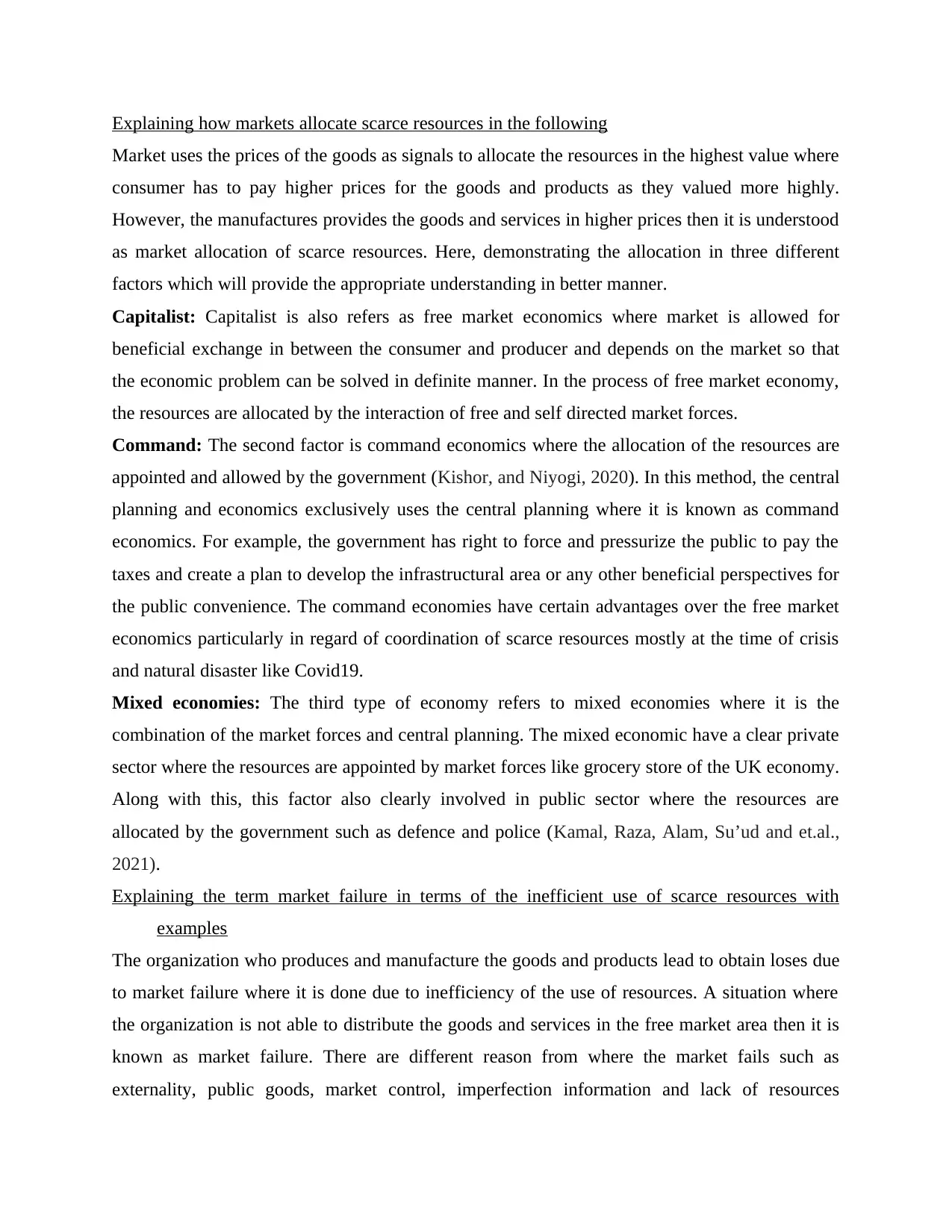
Explaining how markets allocate scarce resources in the following
Market uses the prices of the goods as signals to allocate the resources in the highest value where
consumer has to pay higher prices for the goods and products as they valued more highly.
However, the manufactures provides the goods and services in higher prices then it is understood
as market allocation of scarce resources. Here, demonstrating the allocation in three different
factors which will provide the appropriate understanding in better manner.
Capitalist: Capitalist is also refers as free market economics where market is allowed for
beneficial exchange in between the consumer and producer and depends on the market so that
the economic problem can be solved in definite manner. In the process of free market economy,
the resources are allocated by the interaction of free and self directed market forces.
Command: The second factor is command economics where the allocation of the resources are
appointed and allowed by the government (Kishor, and Niyogi, 2020). In this method, the central
planning and economics exclusively uses the central planning where it is known as command
economics. For example, the government has right to force and pressurize the public to pay the
taxes and create a plan to develop the infrastructural area or any other beneficial perspectives for
the public convenience. The command economies have certain advantages over the free market
economics particularly in regard of coordination of scarce resources mostly at the time of crisis
and natural disaster like Covid19.
Mixed economies: The third type of economy refers to mixed economies where it is the
combination of the market forces and central planning. The mixed economic have a clear private
sector where the resources are appointed by market forces like grocery store of the UK economy.
Along with this, this factor also clearly involved in public sector where the resources are
allocated by the government such as defence and police (Kamal, Raza, Alam, Su’ud and et.al.,
2021).
Explaining the term market failure in terms of the inefficient use of scarce resources with
examples
The organization who produces and manufacture the goods and products lead to obtain loses due
to market failure where it is done due to inefficiency of the use of resources. A situation where
the organization is not able to distribute the goods and services in the free market area then it is
known as market failure. There are different reason from where the market fails such as
externality, public goods, market control, imperfection information and lack of resources
Market uses the prices of the goods as signals to allocate the resources in the highest value where
consumer has to pay higher prices for the goods and products as they valued more highly.
However, the manufactures provides the goods and services in higher prices then it is understood
as market allocation of scarce resources. Here, demonstrating the allocation in three different
factors which will provide the appropriate understanding in better manner.
Capitalist: Capitalist is also refers as free market economics where market is allowed for
beneficial exchange in between the consumer and producer and depends on the market so that
the economic problem can be solved in definite manner. In the process of free market economy,
the resources are allocated by the interaction of free and self directed market forces.
Command: The second factor is command economics where the allocation of the resources are
appointed and allowed by the government (Kishor, and Niyogi, 2020). In this method, the central
planning and economics exclusively uses the central planning where it is known as command
economics. For example, the government has right to force and pressurize the public to pay the
taxes and create a plan to develop the infrastructural area or any other beneficial perspectives for
the public convenience. The command economies have certain advantages over the free market
economics particularly in regard of coordination of scarce resources mostly at the time of crisis
and natural disaster like Covid19.
Mixed economies: The third type of economy refers to mixed economies where it is the
combination of the market forces and central planning. The mixed economic have a clear private
sector where the resources are appointed by market forces like grocery store of the UK economy.
Along with this, this factor also clearly involved in public sector where the resources are
allocated by the government such as defence and police (Kamal, Raza, Alam, Su’ud and et.al.,
2021).
Explaining the term market failure in terms of the inefficient use of scarce resources with
examples
The organization who produces and manufacture the goods and products lead to obtain loses due
to market failure where it is done due to inefficiency of the use of resources. A situation where
the organization is not able to distribute the goods and services in the free market area then it is
known as market failure. There are different reason from where the market fails such as
externality, public goods, market control, imperfection information and lack of resources
Paraphrase This Document
Need a fresh take? Get an instant paraphrase of this document with our AI Paraphraser
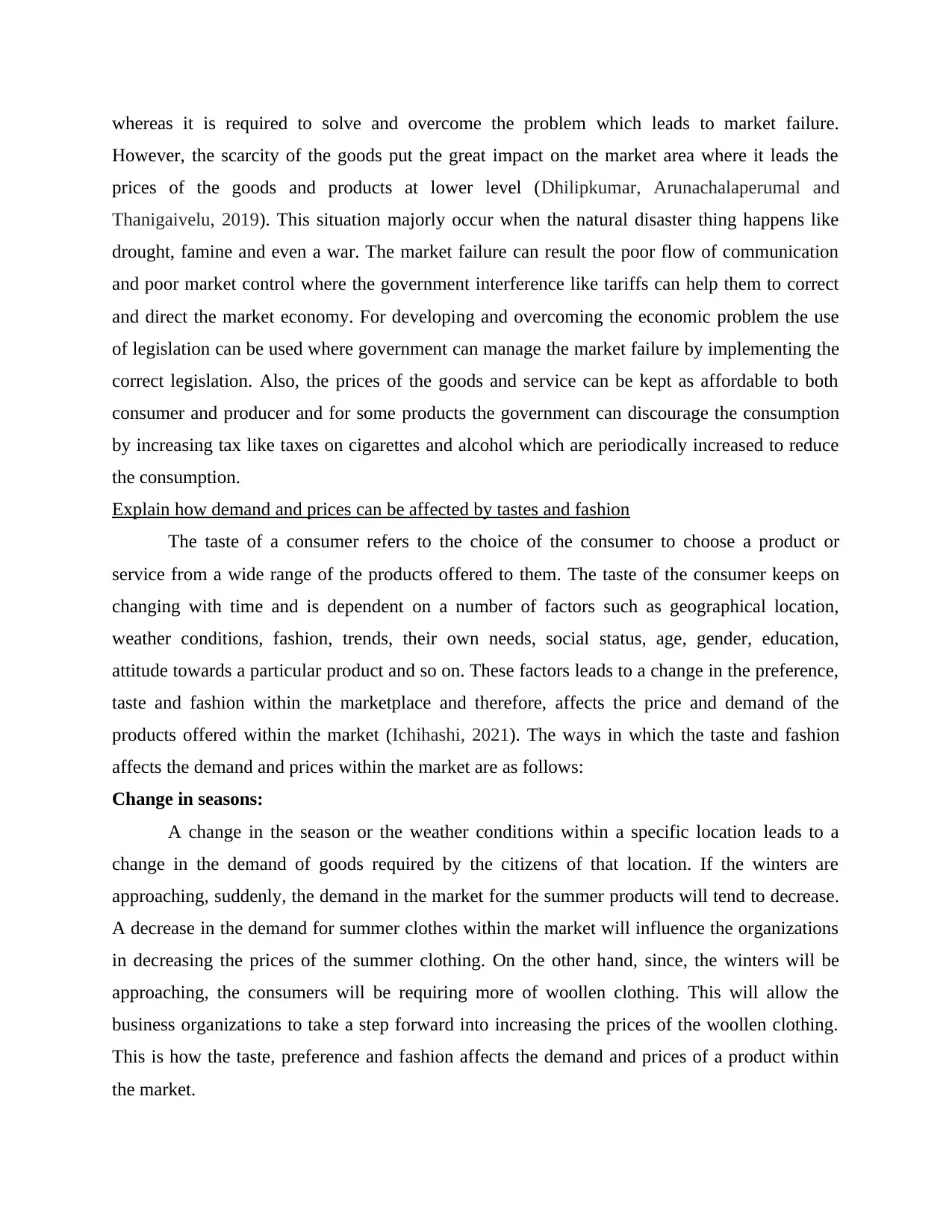
whereas it is required to solve and overcome the problem which leads to market failure.
However, the scarcity of the goods put the great impact on the market area where it leads the
prices of the goods and products at lower level (Dhilipkumar, Arunachalaperumal and
Thanigaivelu, 2019). This situation majorly occur when the natural disaster thing happens like
drought, famine and even a war. The market failure can result the poor flow of communication
and poor market control where the government interference like tariffs can help them to correct
and direct the market economy. For developing and overcoming the economic problem the use
of legislation can be used where government can manage the market failure by implementing the
correct legislation. Also, the prices of the goods and service can be kept as affordable to both
consumer and producer and for some products the government can discourage the consumption
by increasing tax like taxes on cigarettes and alcohol which are periodically increased to reduce
the consumption.
Explain how demand and prices can be affected by tastes and fashion
The taste of a consumer refers to the choice of the consumer to choose a product or
service from a wide range of the products offered to them. The taste of the consumer keeps on
changing with time and is dependent on a number of factors such as geographical location,
weather conditions, fashion, trends, their own needs, social status, age, gender, education,
attitude towards a particular product and so on. These factors leads to a change in the preference,
taste and fashion within the marketplace and therefore, affects the price and demand of the
products offered within the market (Ichihashi, 2021). The ways in which the taste and fashion
affects the demand and prices within the market are as follows:
Change in seasons:
A change in the season or the weather conditions within a specific location leads to a
change in the demand of goods required by the citizens of that location. If the winters are
approaching, suddenly, the demand in the market for the summer products will tend to decrease.
A decrease in the demand for summer clothes within the market will influence the organizations
in decreasing the prices of the summer clothing. On the other hand, since, the winters will be
approaching, the consumers will be requiring more of woollen clothing. This will allow the
business organizations to take a step forward into increasing the prices of the woollen clothing.
This is how the taste, preference and fashion affects the demand and prices of a product within
the market.
However, the scarcity of the goods put the great impact on the market area where it leads the
prices of the goods and products at lower level (Dhilipkumar, Arunachalaperumal and
Thanigaivelu, 2019). This situation majorly occur when the natural disaster thing happens like
drought, famine and even a war. The market failure can result the poor flow of communication
and poor market control where the government interference like tariffs can help them to correct
and direct the market economy. For developing and overcoming the economic problem the use
of legislation can be used where government can manage the market failure by implementing the
correct legislation. Also, the prices of the goods and service can be kept as affordable to both
consumer and producer and for some products the government can discourage the consumption
by increasing tax like taxes on cigarettes and alcohol which are periodically increased to reduce
the consumption.
Explain how demand and prices can be affected by tastes and fashion
The taste of a consumer refers to the choice of the consumer to choose a product or
service from a wide range of the products offered to them. The taste of the consumer keeps on
changing with time and is dependent on a number of factors such as geographical location,
weather conditions, fashion, trends, their own needs, social status, age, gender, education,
attitude towards a particular product and so on. These factors leads to a change in the preference,
taste and fashion within the marketplace and therefore, affects the price and demand of the
products offered within the market (Ichihashi, 2021). The ways in which the taste and fashion
affects the demand and prices within the market are as follows:
Change in seasons:
A change in the season or the weather conditions within a specific location leads to a
change in the demand of goods required by the citizens of that location. If the winters are
approaching, suddenly, the demand in the market for the summer products will tend to decrease.
A decrease in the demand for summer clothes within the market will influence the organizations
in decreasing the prices of the summer clothing. On the other hand, since, the winters will be
approaching, the consumers will be requiring more of woollen clothing. This will allow the
business organizations to take a step forward into increasing the prices of the woollen clothing.
This is how the taste, preference and fashion affects the demand and prices of a product within
the market.
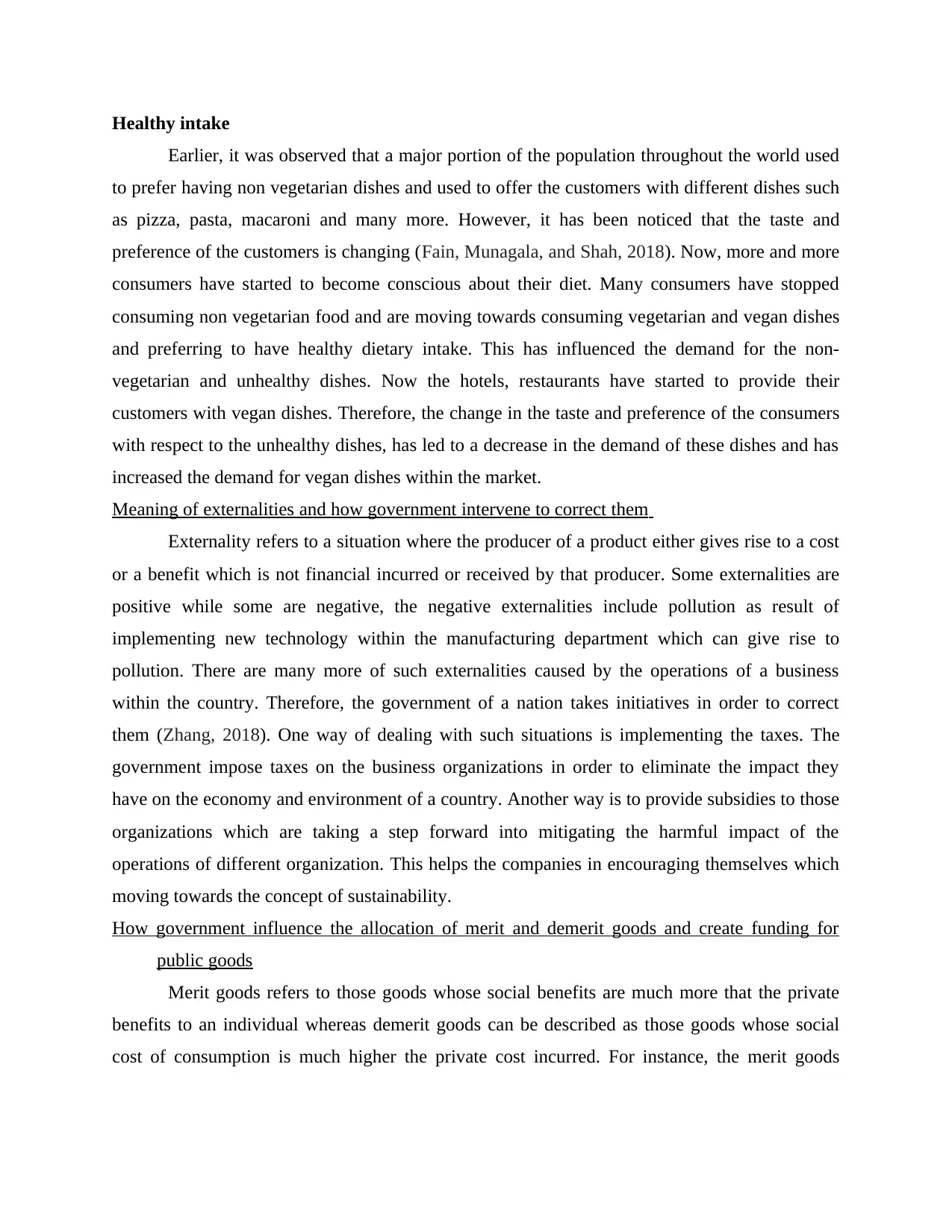
Healthy intake
Earlier, it was observed that a major portion of the population throughout the world used
to prefer having non vegetarian dishes and used to offer the customers with different dishes such
as pizza, pasta, macaroni and many more. However, it has been noticed that the taste and
preference of the customers is changing (Fain, Munagala, and Shah, 2018). Now, more and more
consumers have started to become conscious about their diet. Many consumers have stopped
consuming non vegetarian food and are moving towards consuming vegetarian and vegan dishes
and preferring to have healthy dietary intake. This has influenced the demand for the non-
vegetarian and unhealthy dishes. Now the hotels, restaurants have started to provide their
customers with vegan dishes. Therefore, the change in the taste and preference of the consumers
with respect to the unhealthy dishes, has led to a decrease in the demand of these dishes and has
increased the demand for vegan dishes within the market.
Meaning of externalities and how government intervene to correct them
Externality refers to a situation where the producer of a product either gives rise to a cost
or a benefit which is not financial incurred or received by that producer. Some externalities are
positive while some are negative, the negative externalities include pollution as result of
implementing new technology within the manufacturing department which can give rise to
pollution. There are many more of such externalities caused by the operations of a business
within the country. Therefore, the government of a nation takes initiatives in order to correct
them (Zhang, 2018). One way of dealing with such situations is implementing the taxes. The
government impose taxes on the business organizations in order to eliminate the impact they
have on the economy and environment of a country. Another way is to provide subsidies to those
organizations which are taking a step forward into mitigating the harmful impact of the
operations of different organization. This helps the companies in encouraging themselves which
moving towards the concept of sustainability.
How government influence the allocation of merit and demerit goods and create funding for
public goods
Merit goods refers to those goods whose social benefits are much more that the private
benefits to an individual whereas demerit goods can be described as those goods whose social
cost of consumption is much higher the private cost incurred. For instance, the merit goods
Earlier, it was observed that a major portion of the population throughout the world used
to prefer having non vegetarian dishes and used to offer the customers with different dishes such
as pizza, pasta, macaroni and many more. However, it has been noticed that the taste and
preference of the customers is changing (Fain, Munagala, and Shah, 2018). Now, more and more
consumers have started to become conscious about their diet. Many consumers have stopped
consuming non vegetarian food and are moving towards consuming vegetarian and vegan dishes
and preferring to have healthy dietary intake. This has influenced the demand for the non-
vegetarian and unhealthy dishes. Now the hotels, restaurants have started to provide their
customers with vegan dishes. Therefore, the change in the taste and preference of the consumers
with respect to the unhealthy dishes, has led to a decrease in the demand of these dishes and has
increased the demand for vegan dishes within the market.
Meaning of externalities and how government intervene to correct them
Externality refers to a situation where the producer of a product either gives rise to a cost
or a benefit which is not financial incurred or received by that producer. Some externalities are
positive while some are negative, the negative externalities include pollution as result of
implementing new technology within the manufacturing department which can give rise to
pollution. There are many more of such externalities caused by the operations of a business
within the country. Therefore, the government of a nation takes initiatives in order to correct
them (Zhang, 2018). One way of dealing with such situations is implementing the taxes. The
government impose taxes on the business organizations in order to eliminate the impact they
have on the economy and environment of a country. Another way is to provide subsidies to those
organizations which are taking a step forward into mitigating the harmful impact of the
operations of different organization. This helps the companies in encouraging themselves which
moving towards the concept of sustainability.
How government influence the allocation of merit and demerit goods and create funding for
public goods
Merit goods refers to those goods whose social benefits are much more that the private
benefits to an individual whereas demerit goods can be described as those goods whose social
cost of consumption is much higher the private cost incurred. For instance, the merit goods
⊘ This is a preview!⊘
Do you want full access?
Subscribe today to unlock all pages.

Trusted by 1+ million students worldwide
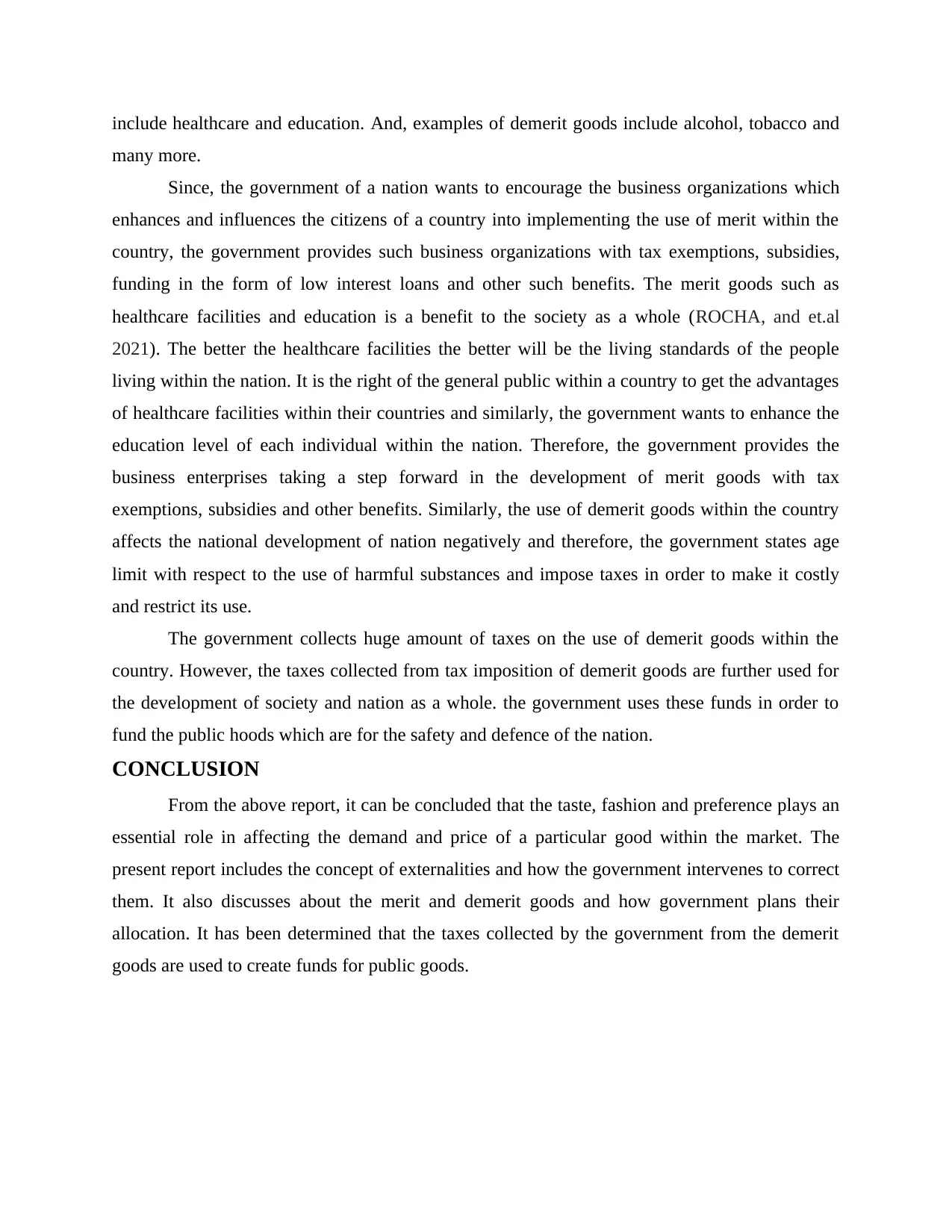
include healthcare and education. And, examples of demerit goods include alcohol, tobacco and
many more.
Since, the government of a nation wants to encourage the business organizations which
enhances and influences the citizens of a country into implementing the use of merit within the
country, the government provides such business organizations with tax exemptions, subsidies,
funding in the form of low interest loans and other such benefits. The merit goods such as
healthcare facilities and education is a benefit to the society as a whole (ROCHA, and et.al
2021). The better the healthcare facilities the better will be the living standards of the people
living within the nation. It is the right of the general public within a country to get the advantages
of healthcare facilities within their countries and similarly, the government wants to enhance the
education level of each individual within the nation. Therefore, the government provides the
business enterprises taking a step forward in the development of merit goods with tax
exemptions, subsidies and other benefits. Similarly, the use of demerit goods within the country
affects the national development of nation negatively and therefore, the government states age
limit with respect to the use of harmful substances and impose taxes in order to make it costly
and restrict its use.
The government collects huge amount of taxes on the use of demerit goods within the
country. However, the taxes collected from tax imposition of demerit goods are further used for
the development of society and nation as a whole. the government uses these funds in order to
fund the public hoods which are for the safety and defence of the nation.
CONCLUSION
From the above report, it can be concluded that the taste, fashion and preference plays an
essential role in affecting the demand and price of a particular good within the market. The
present report includes the concept of externalities and how the government intervenes to correct
them. It also discusses about the merit and demerit goods and how government plans their
allocation. It has been determined that the taxes collected by the government from the demerit
goods are used to create funds for public goods.
many more.
Since, the government of a nation wants to encourage the business organizations which
enhances and influences the citizens of a country into implementing the use of merit within the
country, the government provides such business organizations with tax exemptions, subsidies,
funding in the form of low interest loans and other such benefits. The merit goods such as
healthcare facilities and education is a benefit to the society as a whole (ROCHA, and et.al
2021). The better the healthcare facilities the better will be the living standards of the people
living within the nation. It is the right of the general public within a country to get the advantages
of healthcare facilities within their countries and similarly, the government wants to enhance the
education level of each individual within the nation. Therefore, the government provides the
business enterprises taking a step forward in the development of merit goods with tax
exemptions, subsidies and other benefits. Similarly, the use of demerit goods within the country
affects the national development of nation negatively and therefore, the government states age
limit with respect to the use of harmful substances and impose taxes in order to make it costly
and restrict its use.
The government collects huge amount of taxes on the use of demerit goods within the
country. However, the taxes collected from tax imposition of demerit goods are further used for
the development of society and nation as a whole. the government uses these funds in order to
fund the public hoods which are for the safety and defence of the nation.
CONCLUSION
From the above report, it can be concluded that the taste, fashion and preference plays an
essential role in affecting the demand and price of a particular good within the market. The
present report includes the concept of externalities and how the government intervenes to correct
them. It also discusses about the merit and demerit goods and how government plans their
allocation. It has been determined that the taxes collected by the government from the demerit
goods are used to create funds for public goods.
Paraphrase This Document
Need a fresh take? Get an instant paraphrase of this document with our AI Paraphraser
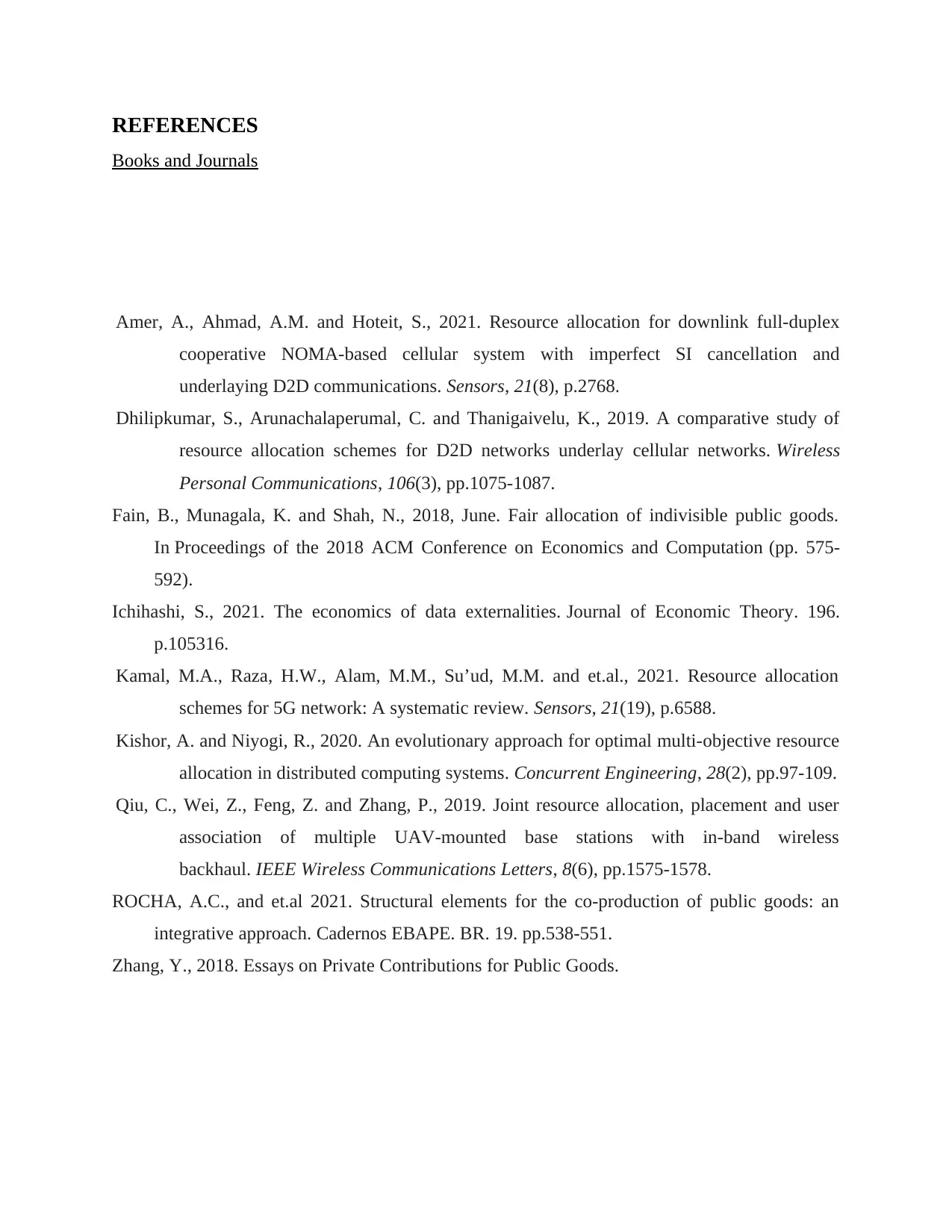
REFERENCES
Books and Journals
Amer, A., Ahmad, A.M. and Hoteit, S., 2021. Resource allocation for downlink full-duplex
cooperative NOMA-based cellular system with imperfect SI cancellation and
underlaying D2D communications. Sensors, 21(8), p.2768.
Dhilipkumar, S., Arunachalaperumal, C. and Thanigaivelu, K., 2019. A comparative study of
resource allocation schemes for D2D networks underlay cellular networks. Wireless
Personal Communications, 106(3), pp.1075-1087.
Fain, B., Munagala, K. and Shah, N., 2018, June. Fair allocation of indivisible public goods.
In Proceedings of the 2018 ACM Conference on Economics and Computation (pp. 575-
592).
Ichihashi, S., 2021. The economics of data externalities. Journal of Economic Theory. 196.
p.105316.
Kamal, M.A., Raza, H.W., Alam, M.M., Su’ud, M.M. and et.al., 2021. Resource allocation
schemes for 5G network: A systematic review. Sensors, 21(19), p.6588.
Kishor, A. and Niyogi, R., 2020. An evolutionary approach for optimal multi-objective resource
allocation in distributed computing systems. Concurrent Engineering, 28(2), pp.97-109.
Qiu, C., Wei, Z., Feng, Z. and Zhang, P., 2019. Joint resource allocation, placement and user
association of multiple UAV-mounted base stations with in-band wireless
backhaul. IEEE Wireless Communications Letters, 8(6), pp.1575-1578.
ROCHA, A.C., and et.al 2021. Structural elements for the co-production of public goods: an
integrative approach. Cadernos EBAPE. BR. 19. pp.538-551.
Zhang, Y., 2018. Essays on Private Contributions for Public Goods.
Books and Journals
Amer, A., Ahmad, A.M. and Hoteit, S., 2021. Resource allocation for downlink full-duplex
cooperative NOMA-based cellular system with imperfect SI cancellation and
underlaying D2D communications. Sensors, 21(8), p.2768.
Dhilipkumar, S., Arunachalaperumal, C. and Thanigaivelu, K., 2019. A comparative study of
resource allocation schemes for D2D networks underlay cellular networks. Wireless
Personal Communications, 106(3), pp.1075-1087.
Fain, B., Munagala, K. and Shah, N., 2018, June. Fair allocation of indivisible public goods.
In Proceedings of the 2018 ACM Conference on Economics and Computation (pp. 575-
592).
Ichihashi, S., 2021. The economics of data externalities. Journal of Economic Theory. 196.
p.105316.
Kamal, M.A., Raza, H.W., Alam, M.M., Su’ud, M.M. and et.al., 2021. Resource allocation
schemes for 5G network: A systematic review. Sensors, 21(19), p.6588.
Kishor, A. and Niyogi, R., 2020. An evolutionary approach for optimal multi-objective resource
allocation in distributed computing systems. Concurrent Engineering, 28(2), pp.97-109.
Qiu, C., Wei, Z., Feng, Z. and Zhang, P., 2019. Joint resource allocation, placement and user
association of multiple UAV-mounted base stations with in-band wireless
backhaul. IEEE Wireless Communications Letters, 8(6), pp.1575-1578.
ROCHA, A.C., and et.al 2021. Structural elements for the co-production of public goods: an
integrative approach. Cadernos EBAPE. BR. 19. pp.538-551.
Zhang, Y., 2018. Essays on Private Contributions for Public Goods.

⊘ This is a preview!⊘
Do you want full access?
Subscribe today to unlock all pages.

Trusted by 1+ million students worldwide
1 out of 9
Related Documents
Your All-in-One AI-Powered Toolkit for Academic Success.
+13062052269
info@desklib.com
Available 24*7 on WhatsApp / Email
![[object Object]](/_next/static/media/star-bottom.7253800d.svg)
Unlock your academic potential
Copyright © 2020–2025 A2Z Services. All Rights Reserved. Developed and managed by ZUCOL.




